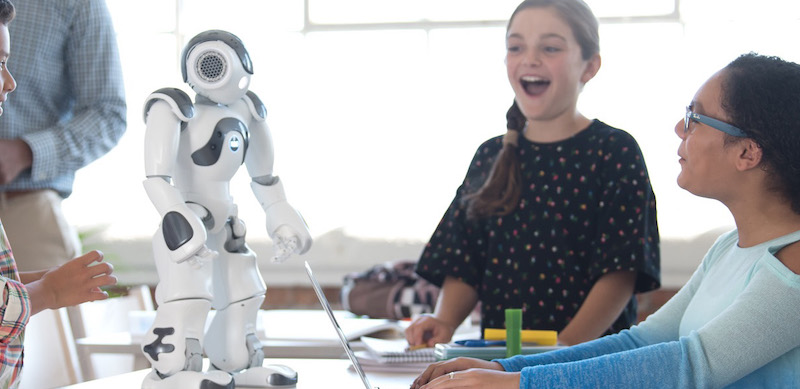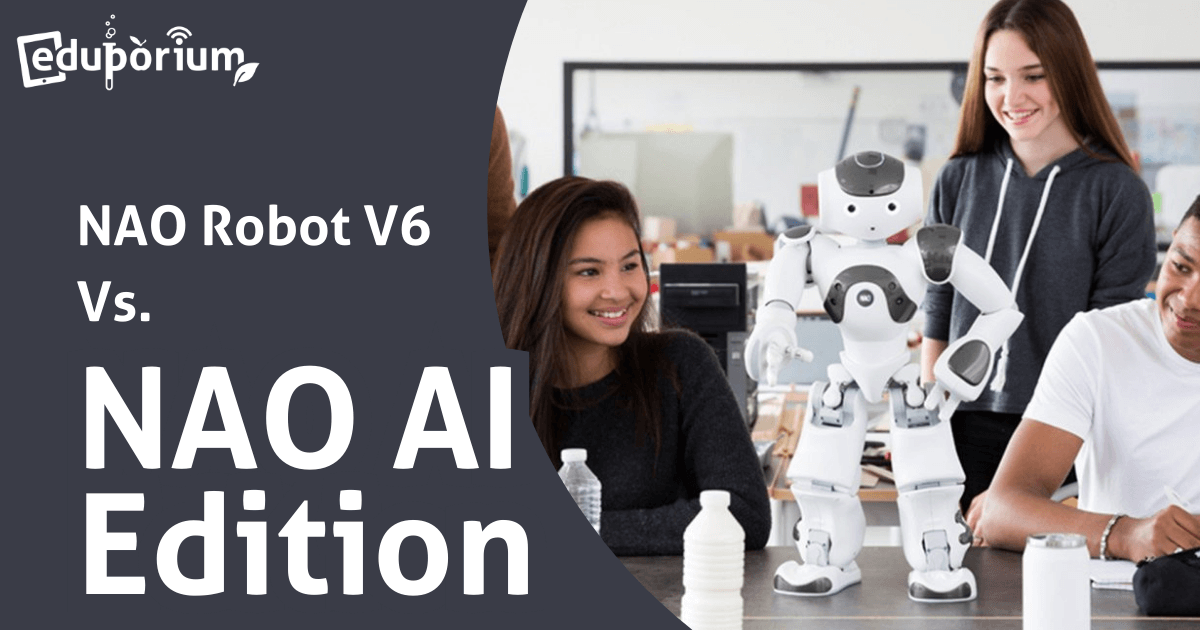Over the past several years, the NAO robot has emerged as a leading educational tool, with an array of advanced functions that make it a helpful companion for high school and college students. It’s not only limited to the upper grades, though. NAO’s voice recognition features and SEL modules make it perfectly suited to interacting with elementary students as well. The humanoid robot stands at just over two feet tall, yet its potential for transforming the learning experience is monumental. Designed with an adaptable personality and a fully programmable system, both the Standard Edition of NAO robot and its AI edition provide plenty of STEM learning opportunities.
Interacting with NAO takes place in a few different ways. All versions of the NAO are fully programmable and come with the ability to sense and interact with their surroundings. Speaking to, looking at, or touching NAO can all inspire the robot to initiate an interaction. Or, students can create applications, animations, and dialogues through the newly improved programming software, Choregraphe. Whether students choose to use voice commands with NAO or write a program, they can customize its behaviors to fit their learning environment.
The most recent version of the NAO robot, the V6, comes in two forms: the Standard model and the AI edition. Although both are very capable robots, it’s important to understand the differences between them so you can choose the best solution for your classroom. Here, we’ll go over the features both robots share, as well as the ones that make each version unique.
NAO V6 Standard Edition
Powerful upgraded hardware
The NAO V6 comes with several hardware updates over the previous version, the V5. The Softbank team upgraded its power bank to increase the time NAO can spend awake. That way, you don’t have to worry about its battery running out in the middle of class. Its memory has also increased from 8 GB to 32 GB—a big improvement! With more memory, NAO can process information up to five times faster than before, making for smoother interactions. Along with these changes, the NAO V6 has a new omnidirectional microphone that picks up sound from anywhere, unlike the previous microphone, which only picked up sound coming from the front or side. This means that students can more easily talk to the robot without worrying about whether NAO can hear them.

NAO’s vision also got a boost with the V6 upgrade. Its eyes consist of two powerful cameras that give the robot 3D vision. Combining its large knowledge database with its recognition algorithms, NAO is able to identify various objects, including faces. The robot measures the distance between various features on a human face in order to distinguish it from others. With the V6, its camera now has an autofocus capability and higher resolution. These upgrades mean that face recognition works even better than before, so it will respond faster to your commands. The V6 also received new speakers, a more robust motor, and improvements to its Wi-Fi speed and finger durability. Unlike previous versions, however, NAO V6 only comes in one color: dark gray. The gray design is sleek and modern—an aesthetic representation of NAO robot’s improvements.
NAO V6’s abilities
NAO is so customizable that it’s difficult to list all of its potential functions in one place! Talking to NAO is the easiest place to start, since it’s so friendly. The robot responds to several dozen pre-determined voice commands, so users can ask questions like, “Are you intelligent?” or “Can you remember me?” NAO will then use its voice and facial recognition abilities and vast database to respond. Users can command the robot to raise its arms, sit or kneel, move and open its hands, and more. Voice commands can also change NAO’s speaking language or even ask it to be friends. The V6 Standard edition comes with one language included for free, though other languages can be added to its database for a fee. Users can choose from up to 20 languages, making NAO accessible throughout the world. When chatting with NAO, its algorithms and motorized joints make it look alive through human-like motion, allowing students to practice reading nonverbal cues alongside spoken communication.
For a more in-depth experience of interacting with NAO, students can program the robot with several coding languages. To start out, they can explore NAO’s drag-and-drop coding environment. NAO’s software, Choregraphe, includes quite a few pre-programmed functions to choose from, such as walking forward or even headbanging. Students drag and drop these function blocks to create a program. Once they’re comfortable with NAO’s abilities and the Choregraphe environment, they can move on to text coding in languages like Python, C++, or Java. Educators can also install various modules to increase NAO’s capabilities.For example, some modules allow NAO to detect levels of darkness or sound, or even identify a landmark and change its behavior accordingly. Clearly, NAO has a ton of versatility—especially in its contemporary versions.
Choregraphe and NAO software
Softbank’s Choregraphe platform is the heart of NAO programming. Purchase of the V6 comes with unlimited access to Choregraphe lessons, as well as start-up and Choregraphe training to familiarize educators with the platform. They’ll also get access to the SDK and API, both of which allow for further customization of the robot’s functionality and are available in 8 languages. For example, the C++ API can add a module that makes NAO react to loud noises in its environment. Or, the Python API could add a collision detection ability that protects the robot from running into other objects. Once students are familiar with coding NAO, they can add any number of abilities to enhance its presence in their lessons.

NAO V6 also includes a simulator where students can run their programs on a virtual robot. There are several versions of the virtual robot, starting with one that’s included in your Choregraphe download. This virtual robot has all of the same capabilities of the physical robot, except for the ability to play audio and recognize speech. If you want to talk with NAO, you’ll have to get a real-life robot. But, if you’re just interested in programming, the simulated NAO is perfectly usable. Another version is the NAOsim, a realistic simulator where you can test the robot’s behaviors in a 3D world. You can insert items in the simulation, such as beds, chairs, and other obstacles. That way, you can safely test your code and make modifications before running it on the real robot.
NAO Robot V6 AI Edition
Overall, the Standard NAO V6 is a robust solution for the classroom. But, if you’re ready to add AI capabilities to robotics learning, upgrading either the V5 or Standard V6 edition to the V6 AI edition is a simple process. We offer a trade-in option with a discount on the AI edition, saving teachers money on the most current robot available. They can save over $5000 by trading in a Standard V6, or $4000 by trading in a V5. AI adds even more functionality to the NAO robot, particularly in conversation, so it’s almost like having another teacher in the classroom!
Hardware and software differences
Although the AI edition of the NAO robot V6 includes the same hardware as the Standard edition, it differs from the Standard in a few key ways. Instead of gray, the AI edition comes in rose gold or copper. It also offers support for two free languages, instead of the one language on the Standard edition. Finally, the AI Edition comes with a one-hour training webinar. Everything else—like access to Choregraphe, the SDK, and the API—remains the same.
Conversation Mode
Of course, the biggest difference between these models is AI capability. While the Standard edition is capable of human interaction through listening and speaking, it is limited. The Standard edition communicates by recognizing key words and phrases, so conversation is confined to a certain number of topics. However, the AI edition’s Conversational Mode allows users to interact as they would with another human. The robot figures out the intent behind the words as you speak, creating a more natural dialogue. All you have to do is connect NAO to an online chatbot like Google’s Dialogflow (NAO’s default). NAO AI can access the internet through Wi-Fi, Ethernet, or 5G, so there are plenty of options for setting up the robot's online interface. As students interact with the robot, it learns to recognize their faces and adapt its conversations by safely storing information about previous interactions.
Presentation Mode
Another AI feature unique to this version of the NAO robot is its Presentation Mode. Students can design interactive slideshow presentations, which NAO will present in a dynamic, human-like manner. When NAO detects passers-by or listeners, it will begin the presentation. As the show goes on, NAO might quiz its listeners on the presentation’s content, display videos, or dance to accompanying music. To increase realism, NAO’s movements are synchronized with the presentation and it makes eye contact with the audience. Presentation Mode could help students show what they’ve learned or allow teachers to switch up how they conduct a lesson.

Which NAO is right for you?
Whether you prefer a Standard NAO with powerful programming opportunities or an AI-enabled NAO with chatbot integration and Presentation Mode, this robot will enrich your classroom and allow students to demonstrate their coding skills in real-world scenarios. For more information and updates on NAO and our other coding robots, follow us on Twitter/X and Instagram and subscribe to our newsletter. You can also reach out to get a NAO quote or ask further questions. Contact us “NAO” for help from our experts!



